Using Lavatubes for Shelter on the Moon & Mars
by Peter Kokh
Lavatubes form as part of the process of spreading sheets of runny lava. So we find them in two types of terrain
- the slopes of shield volcanoes. Unlike cone volcanoes, shield volcanoes have a very low gradual profile, though they can build up to great heights. Mauna Loa/Mauna Kea, i.e. the big island of Hawaii, is the largest shield volcano on Earth. It is full of lavatubes. On Mars this means Olympus Mons and the three great Tharsis ridge volcanoes, Ascraeus, Pavonis, Arsia, and other shield volcanoes elsewhere on the planet.
- They also form
in great lava sheets like those that have flooded much of eastern
Oregon and Washington and southern India. On the Moon, such floods
created the dark gray mare planes that fill many large impact basins.
On Mars, we can look for them throughout the Tharsis ridge uplift, and
maybe in some other areas.
We WON'T find lavatubes everywhere we may want to settle (on other grounds). But WHEN they are to be found in an area that is attractive for other reasons as well, it would be foolish not to incorporate lavatubes with the voluminous radiation - free pre-shielded environments they offer into the plans for our settlement. So we do need to brainstorm this option.
In Fountains of Paradise, Arthur C. Clarke put his capital of Mars within a lavatube complex in Pavonis Mons - more on that below.
If you have ever been in a limestone cave (perhaps most of us have), forget everything you saw. Lavatubes are NOT limestone caves. They form differently and are shaped differently. In general, they are very horizontal with barely perceptible slopes.
Keep in mind that on Mars, with its reduced gravity, lavatubes will be much larger in scale than on Earth, perhaps a hundred meters in cross-section. On the Moon they will be bigger yet. Hadley Rille is universally interpreted as a collapsed lavatube, and it is BIG.
IT IS NOT AN EARLY FRONTIER PERIOD OPTION to Pressurize whole lavatubes or sections of lavatubes with Earth style atmosphere. As attractive as that may be, it is a very advanced task that will require a substantial industrial infrastructure on Mars and so it will come much later, perhaps some generations later. So at first, we are looking at Lavatubes mainly to take care of shielding needs and thus provide relatively "benign environments" in which to put early period modular complexes: residential, commercial, industrial, agricultural.
Readings on Lavatubes: These articles of mine are posted on the Artemis Society website, but unfortunately, the good people at Artemis did not see fit to include the illustrations that accompanied them. I will put those illustrations below. While these articles were written for Moon Miners' Manifesto in the context of what we can expect on the Moon, the great majority of the points made are valid for analogous features on Mars.
6 articles from Moon Miners Manifesto #100, November 1996
1 article from MMM #101, DEC '96
The Potential of Lunar Lavatubes
Illustrations from cited articles

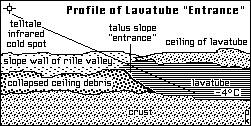
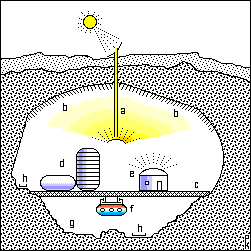
KEY: (a) sunshine access and defuser system; (b)white-washed "firmament" for best sunlight reflection; (c) "town deck" on tube-spanning beams; (d) assorted structures; (e) "yurt/ hogan" type home with translucent dome to flood interior with firmament-reflected sunshine; (f) monorail transit system; (g) lavatube floor left natural; (h) nature walks.
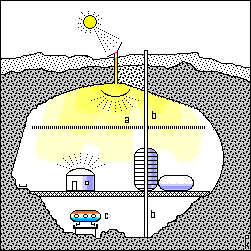
KEY: (a) sunshine access via suspended "daylux" defuser grid instead of coatings; (b) elevator shaft through "skyscraper"; (c) transit system on stiltway over tube floor.
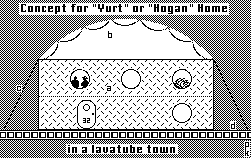
KEY: (a) 2-story vertical cylinder section, bedrooms on the lower level; (b) lunar translation of the geodesic dome for a high translucent ceiling vault over the family room and other common areas including a central garden atrium; glass panes are neither flat nor concave, but convex; (c) cable stays prevent internal pressure from literally "blowing off the roof"; (d) the residential deck of the townsite, leaving the tube floor ungraded.
NOTE: upscaled, the yurt/hogan design will make a fine church, synogog, or meditation chapel, with the simple use of stained glass convex panes in the roof dome. A dedicated shaft of directed sunshine on such a dome would surely help set the mood.
The early lavatube settlement will not be an assembly of individually pressurized buildings, but rather, like the in-surface burrowings, a maze of structures conjoined by pressurized walkways, streets, alleys, and parkways. In the netherspaces, thoroughfare cylinders can be generously paned with convex windows to flood their interiors with ambient reflected and diffused sunshine and views.
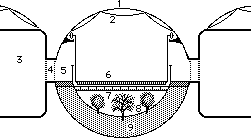
KEY: (1) cylinder section; (2) convex-glass panes to let in ambient reflected sunshine and views; (3) Yurt/hogan style homes opening onto street via entrance tubes (4); (5) pedestrian "sidewalks"; (6) rail-suspended goods delivery platform; (7) "cross-walks"; (8) landscaped, concrete free garden strips; (9) dust-purged, conditioned regolith geoponic soils.
Lavatube complexes could offer "Skylight" "escapes", elevator shafts through the lavatube roof to the surface opening on "domes" or shielded observation "towers" where "tubers" could go to relax, enjoy the surface scenery, walk through an arboretum or flower garden, have a picnic, or enjoy the stars at night. This will be in addition to ambient solar access through fiber optic shafts already illustrated above.
skylights
We have been talking about inflatable structures. Lavatubes are ideal places to put such structures. They do not have to be covered with soil in such situations, and are not exposed to radiation, solar flares, ultraviolet light, meteorite impacts, or fluctuations in ambient temperature. Hybrid rigid-inflatables like the TransHab type with an inflatable torus envelope around a central vertical cylinder works-packed core complex are especially ideal. Pre-inflation, they can be brought down a vertical freight elevator into the lavatube, taken to the deployment location and inflated, hooked up to utilities, and be occupied all in short order.
More on that on the next page

In 1994, I wrote an article about establishing a settlement in the lavatube-riddled western flanks of Pavonis Mons. This is the central shield volcano of the the three large volcanoes on Mars' Tharsis Ridge. It is about as tall as Olympus. On Earth, all shield volcanoes, formed with runny lava, are riddled with lavatubes. Cone volcanoes like Fuji and Vesuvius and Etna, formed from viscous lava are not. So the expectation of finding lavatubes on Mars in similar structures is very high. What is especially interesting about Pavonis Mons (Latin for Peacock Mountain) is that is sits smack on the equator of Mars. So "if ever" we were going to build either a mountain slope launch track on Mars, the western slope of Pavonis Mons is prime turf. And if we were ever going to build a space elevator on Mars, Pavonis' summit would be the anchor point. Pavonis Mons has to be some of the most precious real estate in the solar system.
Here is an overview of the mountain and of the prime site along the western slope and the directions settlement expansion might take.
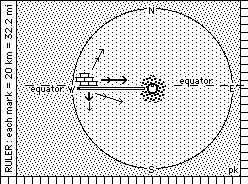
Here is a sketch of how we could connect individual lavatubes into an urban complex. Surface road on top, with subsurface vertical and lateral connectors.

Page 1: Visual and Solar AccessPage 3: Inflatables and Other Big Dumb Volume Options
Page 4: Ideas for a Moon / Mars habitat Demo